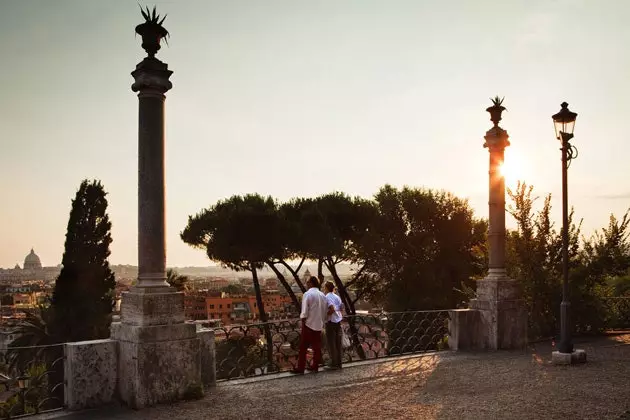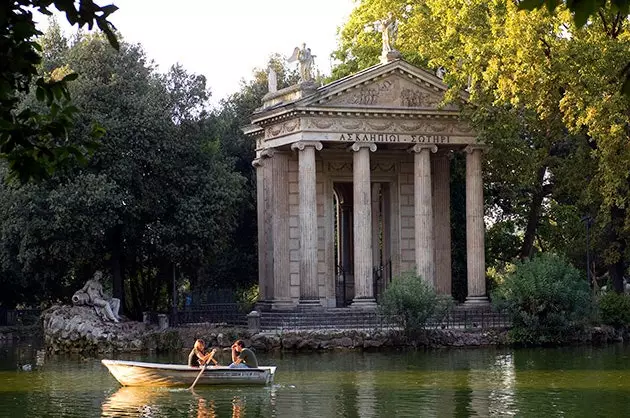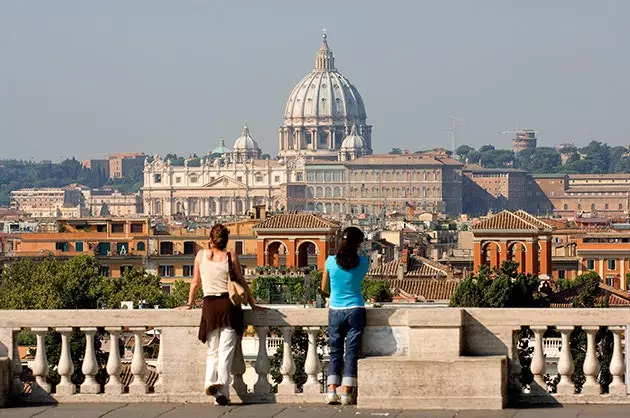
From garden to garden
1)VILLA BORGHESE
"Rome is like a book of fables, on each page you find a prodigy." This is how Hans Christian Andersen described the city where he lived in 1834. These wonders dance and live today in the most peaceful and magical places in the center, among ancient trees like that oriental banana that someone planted back in the 17th century in Villa Borghese, perhaps the most famous park . Among other things, because it is easily accessible from the crowded steps of Piazza di Spagna, and although it is not the largest, it is the most central. Its existence is due to Scipione Borghese, that baroque cardinal, protector of Bernini, who filled Rome with works of art. The route from via dell’Aranciera in the direction of the marvelous Parco di Siena, an oval sand track that was once used for horse racing, is an experience rich in aromas and capricious forms of trees and flowers, depending on the season.
At the beginning of May, for example, from the entrance of the Giardino del Lago you can see a row of little lilac flowers. They are the flowers of Paulonia Tormentosa, a tree native to China, revered for the magical powers of its leaves. Scipione was a great patron of the arts and Villa Borghese, even today, follows that cultural line that marked its creator. The environment brings together cultural academies from various countries; museums such as the Borghese Gallery, the National Museum of Modern Art, the Carlo Bilotti and the Pietro Canonica; and spaces for the representation of the performing arts such as the Silvano Toti Globe Theater and the Casa del Cinema, where very interesting film cycles are organized. Without forgetting the charming terrace of the Casina del Lago, a delicious place to make a stop before approaching the lively Pincio area where Rome appears sublime with views over Piazza del Popolo.
2) CAMILLO PAMPHILI
The honor of being the largest park belongs to Villa Pamphili , built by order of Camillo Pamphili, nephew of Pope Innocent X, back in the 17th century. The area was famous for a breeze of air, so characteristic and healthy, that it ended up giving its name to the main palace: the Casino del Bel Respiro, in whose labyrinth-shaped gardens it is common to see couples cuddling in front of Cupid's fountain. The unconditional ones assure that it is the most beautiful for its wild nature (with meadows and even forests of oaks and cork oaks), for its family character and for the possibilities it offers for outdoor sports, be it running (there is a special point of jogging with changing rooms and showers), play cricket or fly a kite with the members of the famous aquilonisti (kite lovers) group, who meet near the Vitellia Gate. Nearby, inside the park, is the Vivi Bistrot, its Provençal-style décor and organic buffet make it a gastronomic reference for vegetarians and an essential for those looking to eat or drink a prosecco in a place with a lot of charm.
3)VILLA ADA
The other large park, Villa Ada, is ideal for appreciating the small Temple of Flora and what remains of the royal dependencies of the Savoy family who ended up buying the villa and making it a residence and even a hunting reserve. And it is that, indeed, more than a park, it looks like a forest with species as curious as a metasequoya native to China . It was in 1978 that Count Tellfner of Switzerland temporarily took over the property, which he named after his wife. Despite so many illustrious residents, in recent years the park has been the protagonist of popular culture and the favorite of the youngest and most alternative Romans. The main reason is that it hosts the music festival Roma Incontra il Mondo, in which singers from all countries animate the nights of June and July with multi-ethnic rhythms that invite you to dance around the laguetto.

The little boats of Villa Borghese
4) GIARDINO DEGLI ARANCI
The Aventine hill, very close to the Bocca della Verità, keeps the great secret of the lock of the palace of the Knights of Malta, the Basilica of Santa Sabina, the legend that it was here that the city was founded, and the Giardino degli Aranci ( The orange tree garden) which, without a doubt, is the most romantic. Its views offer a wonderful panorama from which domes, roofs and bell towers can be identified. It belongs to what was once the fortress of the Savelli family, of which today only the walls remain. The main entrance is located in the small Pietro d'Illiria square, where a large figurehead, the work of Giacomo della Porta, welcomes everyone who comes looking for a moment of relaxation or a corner to fall in love.
5) MOUNT CELIO
A few minutes from there, you can access Monte Celio, elevated between the Colosseum and the Baths of Caracalla . In 1553 it was a vineyard land that Giacomo Mattei acquired for 1,000 gold shields; although it was not until 1580 when his relative Ciriaco transformed it into Villa Celimontana or Mattei (today the headquarters of the Italian Geographical Society). Until last year, the charm of this park made it the night scene of the prestigious Jazz Festival. Unfortunately, the budget cuts have not spared even one of the city's most traditional events, although that does not prevent them from continuing to enjoy the walks among the many species of trees and plants that once gave shade to the pilgrims who visited it. they crossed on their way to visit the Seven Churches established by Felippo Neri. The park is well stocked with works of art and archaeological remains. Those looking for legends will have a great time at the Egyptian obelisk of Ramses II in whose upper sphere, they say, rest the ashes of Augustus. Chi knows.
6)GIARDINI OF GIANICOLO
Now Romans enjoy summer nights on the fashionable terraces at the Giardini del Gianicolo. The views from this hill, located above the typical neighborhood of Trastevere, are fascinating. At the end of the 19th century, the place was the scene of great and fierce battles between the Roman resistance and the French. Today, it is a peaceful place, frequented by Romans who live in the upper part of the area and tourists with cameras in hand ready to capture the panorama. In summer there is a wonderful terrace. in the middle of the gardens stands an equestrian statue of the Italian leader Garibaldi, from where, every day, a cannon fires at noon to mark the time. For naturists, the option is to go to the neighboring and spectacular botanical garden that houses more than 8,000 species. Art lovers will want, however, to stroll through the pleasant groves of the gardens until they reach the Fontana dell'Acqua Paola, the Academy of Spain and the small church of San Pietro in Montorio, in whose cloister the famous bandstand is located. Twine. Essential!
7) MOUNT MARIO
Opposite the Flaminio district, on the other side of the river, rises the Monte Mario, the highest hill in the city . Part of this hill has been declared a Nature Reserve and is a true mosaic of biological diversity . Its two illustrious villas are Mazzanti, today the headquarters of the RomaNatura institution, which is responsible for protecting the natural areas of the Commune of Rome; and Villa Mellini, former residence of Cardinal Mario Mellini, from whom, it is said, he adopted the name. That memorable palace currently houses the headquarters of the Roman Astronomical Observatory. Although it is also possible to enjoy the panorama without the need for telescopes from "the zodiac", a natural viewpoint that attests that the beauty of Rome is infinite and eternal.

Rome with a view
